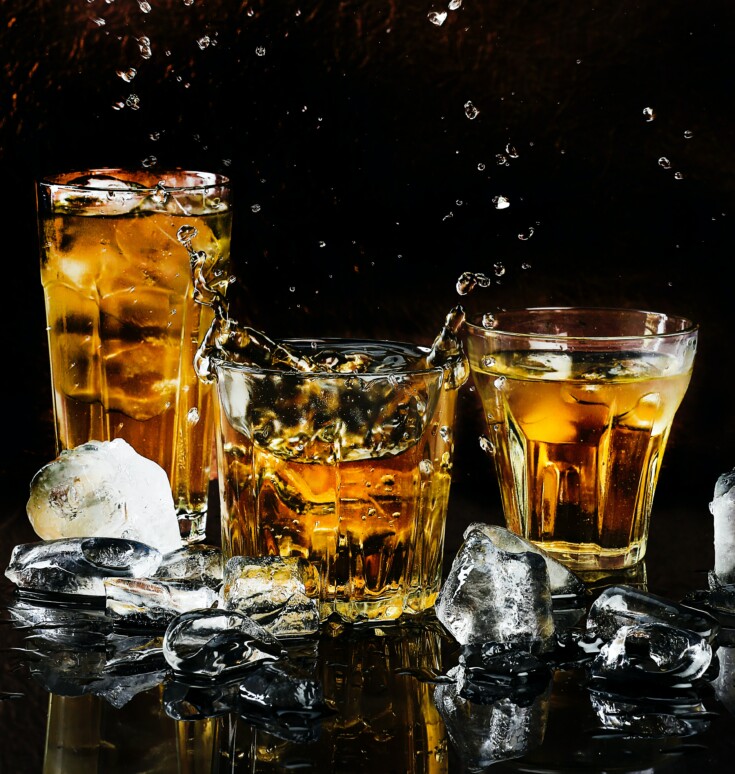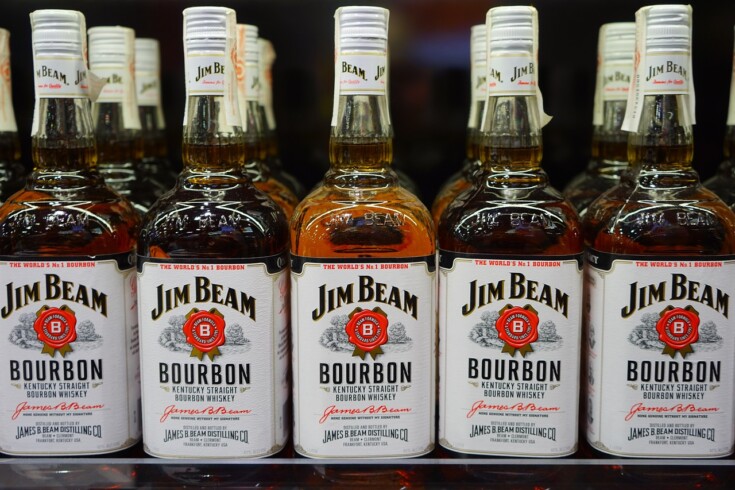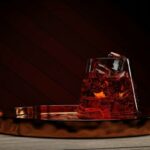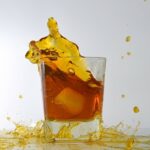
Bourbon is a type of whiskey that is primarily made from corn and aged in charred oak barrels. One of the most noticeable characteristics of bourbon is its color, which can range from a light golden hue to a deep amber shade. But what gives bourbon its distinctive color?
Understanding the color of bourbon is important for both casual drinkers and connoisseurs alike. It can provide insight into the age and quality of the bourbon, as well as its flavor profile. In the following article, we will explore the various factors that contribute to the color of bourbon and how it affects the overall drinking experience.
Table of Contents
Color of Bourbon
Bourbon is known for its rich, dark color that ranges from reddish-brown to amber. The color of bourbon is a result of the aging process, as it spends several years in charred new oak barrels. The barrels are charred to release the natural sugars and flavors of the oak, which then infuse into the bourbon.
The longer the bourbon is aged, the darker its color will be. The color of bourbon is an important indicator of its age, as well as its quality. The color can also provide clues about the production process and the type of barrel used.
Bourbon’s color varies with oak type and barrel char level. American white oak is common, but other oaks can add unique flavors. Heavier char results in a darker hue.
Factors Affecting Bourbon’s Color
 photo credit: pixabay.com
photo credit: pixabay.com
Role of the Barrel
Bourbon’s color is an essential indicator of its age and quality. The barrel plays a significant role in giving bourbon its characteristic color.Bourbon can only legally be called bourbon if it’s aged in a new oak barrel. The reason for this is that the new barrel imparts more flavor to the bourbon than a used barrel would. The charred oak barrel also helps to filter out impurities and unwanted flavors, resulting in a smoother and more refined bourbon.
The barrels are made of American white oak, which is known for its porous nature. During the aging process, the bourbon interacts with the wood, which contributes to its flavor and color.
The charred barrel imparts a smoky flavor to the bourbon, and as the spirit seeps into the wood, it also absorbs the wood’s natural sugars and tannins. The longer the bourbon stays in the barrel, the more flavors and color it will acquire. The barrel’s char also acts as a filter, removing impurities from the bourbon and giving it a smooth finish.
Duration of Aging
The duration of aging is another crucial factor that affects the color of bourbon. The longer the bourbon stays in the barrel, the darker its color becomes. Bourbon that has been aged for a short time will have a lighter color, while bourbon aged for a longer time will have a darker color.
According to the United States government regulations, bourbon must be aged for a minimum of two years in a new, charred oak barrel to be labeled as “straight bourbon.” However, most bourbons are aged for much longer, with some premium brands being aged for up to 23 years. The aging process is a delicate balance between time, temperature, and humidity, and it requires a skilled distiller to produce a high-quality bourbon.
The longer the bourbon stays in the barrel, the more flavors and color it will acquire. The charred barrel also acts as a filter, removing impurities from the bourbon and giving it a smooth finish. Thus, the duration of aging and the role of the barrel play a crucial role in the color and quality of bourbon.
Distillation Process
The distillation process can also impact the color of bourbon. The length of time the bourbon is distilled and the temperature at which it is distilled can both affect the color. Bourbon that is distilled for a longer period of time can have a darker color, while bourbon that is distilled at a lower temperature can be lighter.
Storage Conditions
Perhaps the most significant factor affecting the color of bourbon is the storage conditions. The temperature and humidity of the storage environment can also play a role. Bourbons aged in warmer, more humid conditions tend to have a darker color than those aged in cooler, drier environments.
Comparing Bourbon’s Color to Other Whiskeys
When it comes to whiskey, the color can vary depending on the type of whiskey and how long it has been aged. Bourbon, like other whiskeys, can range in color from light straw to dark amber, but how does its color compare to other types of whiskey?
Bourbon Vs Scotch
Scotch whisky is made from malted barley and aged in oak barrels. It is known for its smoky flavor and aroma. The color of Scotch can range from pale gold to dark amber, depending on the type of barrel it is aged in and how long it has been aged. However, compared to bourbon, Scotch tends to have a lighter color. This is because Scotch is typically aged in used barrels that have already been used to age other spirits, such as bourbon or sherry. The barrels have already imparted some of their color and flavor to the previous spirit, leaving less for the Scotch.
Bourbon Vs Irish Whiskey
Irish whiskey is made from a blend of malt, cereal grain, and barley, and is aged in oak barrels. It has a smoother and lighter taste compared to bourbon. However, compared to bourbon, Irish whiskey tends to have a lighter color. This is because Irish whiskey is typically aged in used barrels that have already been used to age other spirits, such as bourbon or sherry.
Misconceptions About Bourbon’s Color
While the color of bourbon is a fascinating topic, it is also rife with misconceptions. Here are some of the most common misconceptions about the color of bourbon:
Misconception 1: Bourbon’s color indicates its quality
Many people believe that the darker the color of bourbon, the better its quality. However, this is not necessarily true. The color of bourbon is primarily determined by the type of barrel it is aged in and the length of time it spends in the barrel. While longer aging times can result in a darker color, it doesn’t necessarily mean that the bourbon is of higher quality.
Misconception 2: Bourbon’s color is a result of added caramel coloring
Some people believe that bourbon’s color is a result of added caramel coloring. However, this is not true. According to the Tasting Table, adding caramel coloring to bourbon is illegal. Bourbon’s color is a result of the interaction between the liquid and the charred oak barrel it is aged in.
Misconception 3: All bourbon is the same color
While bourbon is typically a dark, reddish-brown color, not all bourbons are the same color. The color of bourbon can vary based on a number of factors, including the type of barrel it is aged in, the length of time it spends in the barrel, and the location where it is aged. For example, bourbons aged in cooler climates may be lighter in color than those aged in warmer climates.
Misconception 4: Bourbon’s color is a result of the mash bill
While the mash bill (the combination of grains used to make the bourbon) can impact the flavor of the bourbon, it does not have a significant impact on the color. The color of bourbon is primarily determined by the aging process and the type of barrel it is aged in.
Frequently Asked Questions
Can bourbon be clear or colorless?
No, bourbon cannot be clear or colorless. Bourbon gets its color from aging in charred oak barrels. The longer the bourbon is aged, the darker the color becomes. The color of bourbon can range from light amber to a deep, rich mahogany.
Do different types of bourbon have different colors?
Yes, different types of bourbon can have different colors depending on how long they are aged and the type of barrel they are aged in. For example, bourbon aged in a new charred oak barrel will have a darker color than bourbon aged in a used barrel.
Is the color of bourbon an indication of its quality?
No, the color of bourbon is not necessarily an indication of its quality. While the color can give a general idea of how long the bourbon has been aged, it does not necessarily reflect the taste or quality of the bourbon. The taste and quality of bourbon depend on many factors, including the mash bill, the distillation process, and the aging conditions.
Conclusion
The color of bourbon is an important factor that contributes to its overall appeal and value. The color of bourbon varies depending on the aging process, but it is typically a golden brown or reddish-brown hue.
The aging process of bourbon plays a significant role in its color. The longer it is aged, the darker the shade of the bourbon will be. The color of the bourbon is important because it is one of the age indicators. Bourbon must be aged in new, charred oak barrels, which gives it its distinct flavor and color.
The color of bourbon is not only important for its appearance but also for its taste. The color of bourbon can indicate the flavor profile of the whiskey. Darker bourbons tend to have a richer, more complex flavor profile, while lighter bourbons have a milder flavor.
In conclusion, the color of bourbon is an important factor that contributes to its overall appeal and value. The aging process, the type of barrel used, and the length of time it is aged all play a role in the color of bourbon. The color of bourbon can indicate its age and flavor profile, making it an important aspect of the whiskey-making process.



